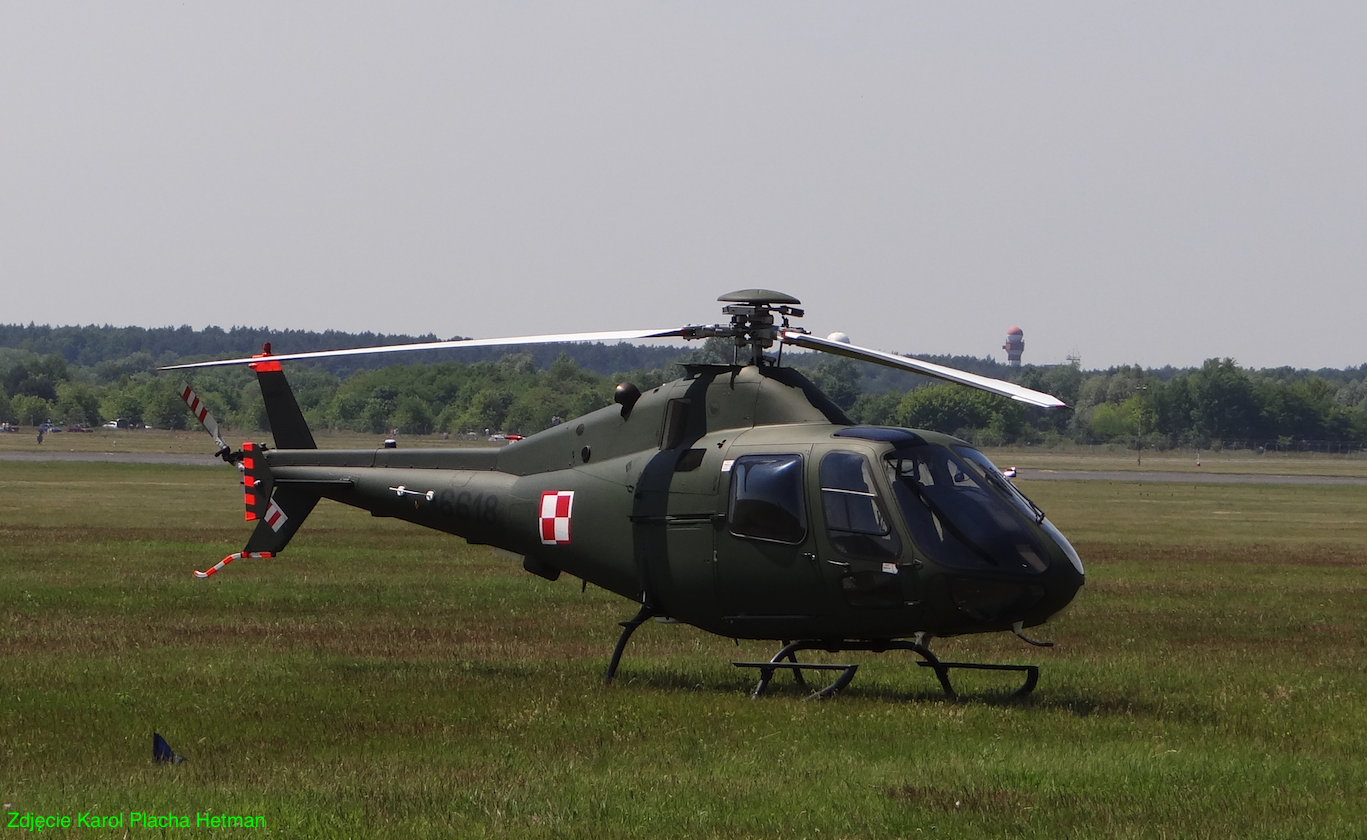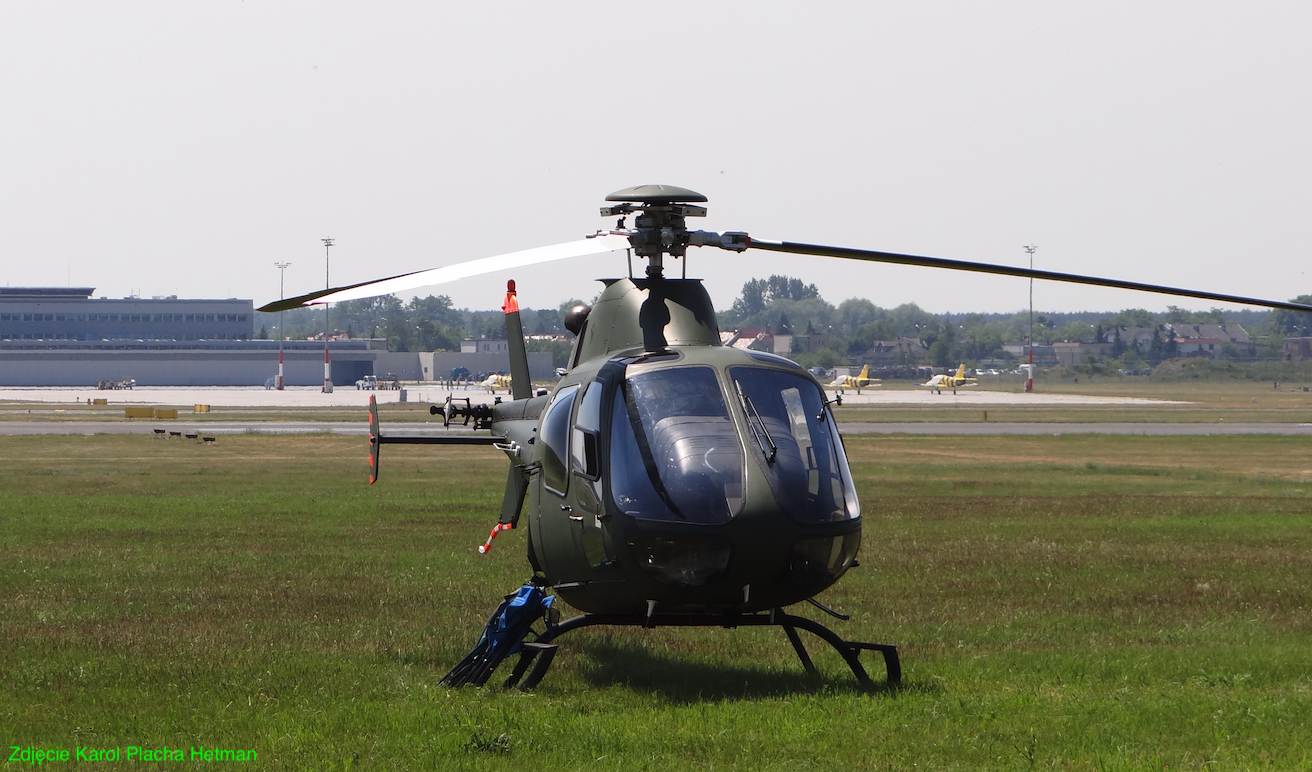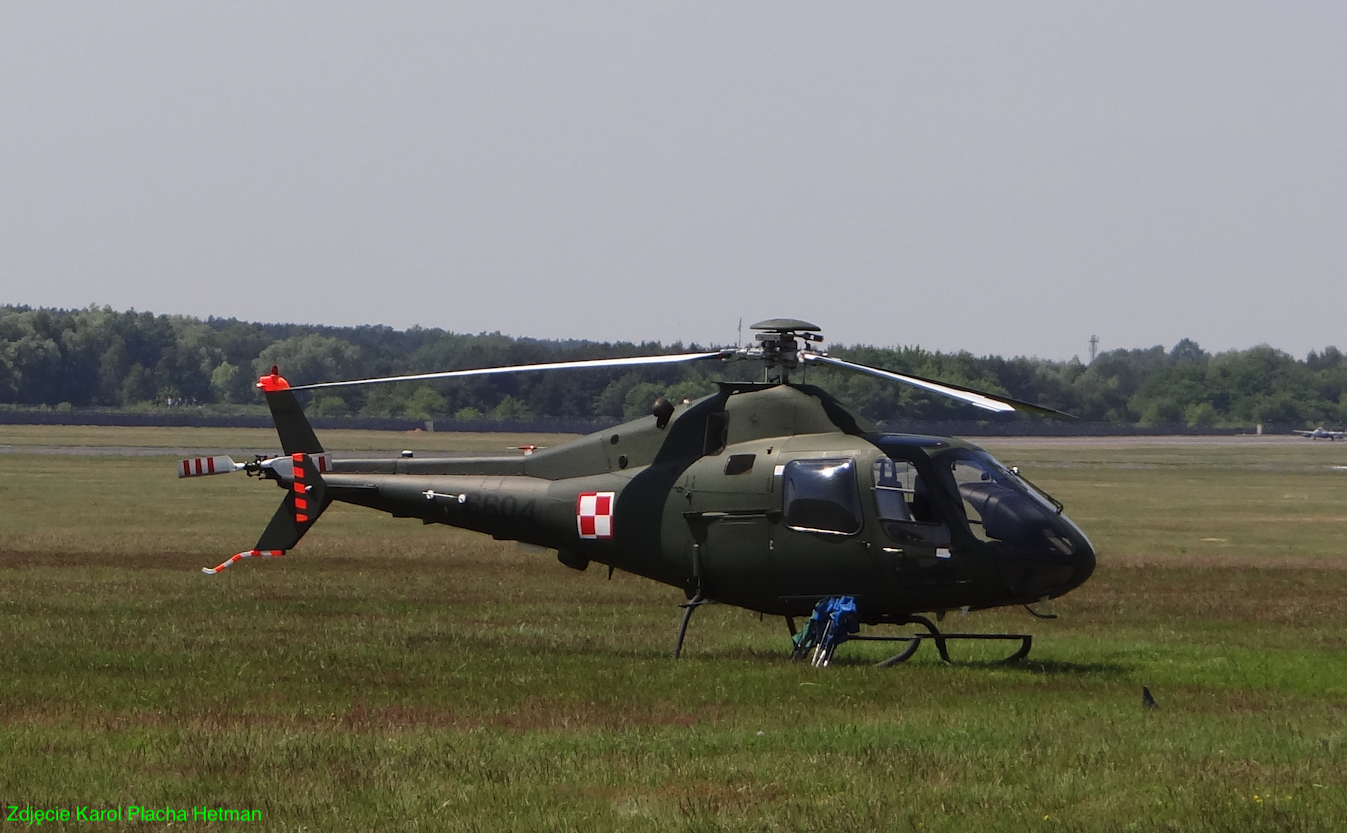Warszawa 2019-05-12
PZL Świdnik SW-4 Puszczyk.
290b Section 26.10.1996 year.
Construction of the PZL SW-4 Puszczyk helicopter.
The PZL SW-4 is a light helicopter built in a classic (Sikorsky) layout, with a three-blade main rotor and a two-blade tail rotor. The drive unit consists of one turbine engine.
The SW-4 cabin in the basic variant is adapted to carry 5 people (pilot + 4 passengers). There are two seats in the front and three in the back. All of them are adapted to absorb energy in the event of an emergency landing and have seat belts. It is equipped with a heating and ventilation system, it is also possible to install air conditioning as an option.
The fuselage of the mixed-construction helicopter is made of metal and composite. The half-shell skeleton is made of aluminum alloys. The cover in the front part is made of glass-epoxy composites. The length of the cabin is 2.340 m, width 1.403 m, height 1.250 m. The walls of the cabin are lined with thermal and acoustic insulation. The cabin is richly glazed. The windows are made of organic glass (plexiglass). The cabin has been equipped with front doors on both sides, opened in a car-like manner, with dimensions of 0.65 m x 1.15 m and a rear sliding door with dimensions of 0.82 m x 1.15 m. The windows in the rear door windows are convex to improve visibility. There is no pillar between the front and rear doors for easy loading. In the rear part of the fuselage there is a trunk with a capacity of 0.83 cubic meters for 150 kg of cargo, as well as a compartment for radio and navigation equipment.
Under the fuselage of the helicopter, it is possible to install the On Board System Talon LC external sling with a lifting capacity of 650 kg. It is used, for example, for fire-fighting tasks.
Tail boom with half-shell metal structure. In its final part, the tail rotor gearbox was placed. The tail rotor drive shaft runs above the tail boom and is covered by a cover.
The SW-4 is equipped with a skid landing gear typical of light helicopters. They are made of duralumin alloys with steel overlays. For transporting the helicopter in the hangar and parking planes, additional wheels are used.
SW-4 helicopter drive.
The SW-4 is powered by one Rolls Royce Model 250 C20/R-2(SP) turbine engine with a power of 336 kW (456 hp).
The Model Allison 250 engine, now known as the Rolls-Royce Model 250 (U.S. military designations T63 and T703), is a highly successful family of turboshaft engines originally developed by the Allison Engine Company in the early 1960s. In 1995, Rolls-Royce acquired Allison.
In 1958, Allison was selected by the US Army to develop a new turbine engine to power small military aircraft. In the initial stage, the USAF was unsure whether the engine was to be turbojet or turboprop. Therefore, Allison worked on both variants. In 1960, it was decided that the engine should be turboprop, because it would allow the construction of aircraft in the then fashionable vertical take-off configuration. There was even an airplane with a rotating wing and engines attached to it. This is how the engine designated YT63-A-3 was created, which was first used to power the Bell 47 helicopter, which first flew in 1961. Soon a version of the engine designated YT63-A-5 was developed, in which the exhaust outlet was directed upwards. The idea was to avoid grass fires during landing in an area unprepared for helicopter take-offs and landings. The engine has a power of 250 hp and this is how the entire family of Model 250 engines was born. For the Model 250, Allison used a reverse airflow configuration. The gases in the engine reverse direction twice; by 180 degrees and 90 degrees. The engine consists of an axial compressor with a centrifugal final stage, a combustion chamber, a 2-stage turbine (1-stage on early models), and a 2-stage freewheel turbine that generates shaft power for the propeller or main rotor. The gas outlet is directed laterally into two exhaust channels that form a V-shape. An important feature of the Model 250 engine is its modular design, which greatly simplifies maintenance and repair operations. Also, the unique backflow design makes it easy to keep the section hot.
Approximately 30,000 Model 250 engines were built, of which approximately 16,000 are still in service. The Model 250 engine was and is built in about 48 versions, powers 16 types of aircraft and 28 types of helicopters.
Earlier versions of the Model 250 engine have 7 axial compressor stages mounted on the HP (high pressure) shaft and 1 radial stage. The static pressure is 7.2:1, with an airflow of 3.45 lb/s (1.8 kg/s), with a shaft power output of 420 hp (310 kW). The newer versions have a pressure ratio of 9.2:1 with an air flow of 6.1 lb/s (2.8 kg/s) and a shaft power of 715 hp (533 kW). Basic dimensions; length 1.03 m, maximum width 0.57 m, weight 62 kg. The maximum temperature in front of the turbine is 985 degrees Celsius. The engine can operate on various types of aviation fuels for turbojet engines (kerosene) (JP-4-kerosene, JP-1, JP-5). The engine has its own lubrication system with a pump, reservoir and filter system. Electronic engine control. The engine is equipped with a fire protection system. The air intake can be equipped with a dust filter and an exhaust diffuser to reduce the thermal footprint.
The SW-4 fuel tank has a capacity of 478 liters, which, with fuel consumption of 98-120 l/h, allows for a maximum of 5 hours of flight. It is made of such materials that it is resistant to crushing in the event of a forced landing. The tank was placed in the central part of the hull under the main gear compartment.
The SW-4 main rotor of the SW-4 helicopter is three-bladed, articulated. The blades are made of a glass-epoxy composite.The SW-4 tail rotor was made in the same technology as the main rotor. The propeller is two-bladed.
SW-4 equipment. The control system of the SW-4 helicopter is based on a cable-pusher system. The system uses hydraulic support. Classic tillers were used, which were doubled in the school variant. The piloting and navigation equipment of the SW-4 is a set of on-board instruments by Bendix-King, enabling VFR (Visual Flight Rules) flights, and cabin lighting adapted to be used by the crew of NVG goggles. In addition, the avionics can be extended with instruments enabling flights without visibility of the ground IFR (Instrument Flight Rules), as well as specialized piloting and navigation equipment and a three-axis autopilot.
List of SW-4 helicopters.
The Polish Army received 24 PZL Świdnik SW-4 Puszczyk helicopters, which complemented the PZL Mi-2 helicopters. They are mainly used for training helicopter pilots.
1 Production Series: SW-4 No. 600101 – prototype for static tests. SW-4 No. 600102 – prototype for ground tests. SW-4 No. 600103 SP-PSW – the first flying prototype. SW-4 No. 600104 SP-PSZ – second flying prototype.
2 Production series: 01 SW-4 No. 660201 (previously No. 0201) Nb 6601, 2005, user 1. OSzL. 02 SW-4 No. 660202 Nb HL9402, SP-PSY, 2006, user Kim’s Solution, PZL Świdnik. 03 SW-4 No. 660203 (previously No. 0202) No. 6603, 2006, user 1. OSzL. 04 SW-4 No. 660204, No. 6603 (previously No. 0204) No. 6603, 2006, user 1. OSzL. 05 SW-4 No. 660205, No. 6605 (previously No. 0205) No. 6604, 2006, user 1. OSzL.
3 Production Series: 01 SW-4, 2008, No. 660301, Nb 6605. 02 SW-4, 2008, No. 660302, Nb 6606. 03 SW-4, 2008, No. 660303, Nb 6607. 04 SW-4 2008, No. 660304, Nb 6608. 05 SW-4, 2008, No. 660305, Nb 6609. 06 SW-4, 2008, No. 660306, Nb 6610. 07 SW-4, 2008, No. 660307, Nb 6611, was received by the military on August 11, 2008. 08 SW-4, 2008, No. 660308, Nb 6612. 09 SW-4, 2008, No. 660309, Nb 6613. 10 SW-4, 2009, No. 660310, Nb 6614. 11 SW-4, 2009, No. 660311, Nb 6615. 12 SW-4, 2009, No. 660312, Nb 6616. 13 SW-4, 2009, No. 660313, Nb 6617. 14 SW-4, 2009, No. 660314, Nb 6618. 15 SW -4, 2009, No. 660315, Nb 6619. 16 SW-4, 2009, No. 660316, Nb 6620. 17 SW-4, 2009, No. 660317, Nb 6621. 18 SW-4, 2009, No. 660318 , Nb 6622. 19 SW-4, 2009, No. 660319, Nb 6623. 20 SW-4, 2009, No. 660320, Nb 6624. 21 SW-4, 2009, No. 660321, Nb 6625. 22 SW-4 2009, No. 660322, UR-SASW, private. 23 SW-4, 2009, No. 660323, Nb 6626. 24 SW-4, 2009, No. 660324, SP-SWV, PZL Świdnik.
Written by Karol Placha Hetman



